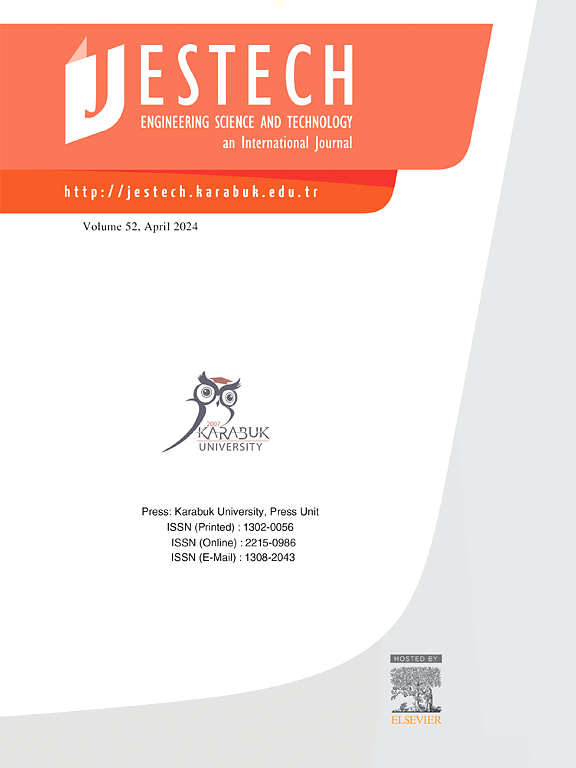Rapid control prototyping of sensorless control system for PMSM based on multi-agent reinforcement learning and fractional order sliding mode control
IF 5.1
2区 工程技术
Q1 ENGINEERING, MULTIDISCIPLINARY
Engineering Science and Technology-An International Journal-Jestech
Pub Date : 2025-04-11
DOI:10.1016/j.jestch.2025.102054
引用次数: 0
Abstract
Based on the overall Field Oriented Control (FOC) control strategy of a Permanent Magnet Synchronous Motor (PMSM), a flexible and efficient control system architecture is developed in this work to achieve superior control performance. Sliding Mode Control (SMC) laws are utilized for both the inner and outer loop, but the typical cascade control characteristic of the system is maintained. Thus, the inner loop (IL) control laws are designed to provide increased flexibility by using fractional order (FO) computation and a response speed that is an order of magnitude higher than that of the outer loop (OL). The optimization of the tuning parameters of these controllers is performed by a computational intelligence (CI) algorithm, more specifically the Improved Grey Wolf Optimizer-Cuckoo Search Optimization (IGWO-CSO). The minimization of the computation time in the implementation of control algorithms is achieved by using a neural network (NN) that estimates the derivative value of the sliding surface in the structure of the SMC type speed controller. A term is added to the control law to cancel global perturbations of the system model, estimated with a Disturbance Observer (DO). Mitigation of the numerical stability problems of the derivative computation is achieved by using a Levant observer tracking differentiator. The use of Multi-Agent Reinforcement Learning (MARL) based on three properly trained Twin-Delayed Deep Deterministic (TD3) RL agents, which provide correction signals overlapping the control signals, contributes to the superior performance of the sensorless control system of the PMSM (SCS-PMSM). These include both parametric robustness to parameter and load torque variations, but also the use of an adaptation law to estimate the stator resistance, which can vary significantly. The superiority of the proposed SCS-PMSM over a benchmark control system based on Proportional Integrator (PI) controllers is demonstrated by following both the Software-in-the-Loop (SIL) and Hardware-in-the-Loop Simulated-Rapid Control Prototyping (HILS-RCP) phases. The realization of an RCP for the proposed RCP SCS-PMSM at different sampling periods corresponding to the implementation in both high performance and low/medium performance Digital Signal Processors (DSPs) is achieved using a SpeedGoat Performance Real-Time Target Machine platform.
基于多智能体强化学习和分数阶滑模控制的永磁同步电机无传感器控制系统快速控制原型
本研究基于永磁同步电机 (PMSM) 的总体场导向控制 (FOC) 控制策略,开发了一种灵活高效的控制系统架构,以实现卓越的控制性能。内环和外环均采用滑动模式控制 (SMC) 法,但系统的典型级联控制特性得以保持。因此,内环(IL)控制法则的设计通过使用分数阶(FO)计算和比外环(OL)高一个数量级的响应速度来提高灵活性。这些控制器调节参数的优化采用计算智能(CI)算法,更具体地说是改进型灰狼优化器-布谷鸟搜索优化(IGWO-CSO)算法。通过使用神经网络(NN)估算 SMC 速度控制器结构中滑动面的导数值,实现了控制算法实施过程中计算时间的最小化。控制法则中添加了一个项,用于抵消系统模型的全局扰动,该扰动由扰动观测器(DO)估算。通过使用 Levant 观察器跟踪微分器,可以缓解导数计算的数值稳定性问题。多代理强化学习(MARL)以三个经过适当训练的双延迟深度确定性(TD3)RL 代理为基础,提供与控制信号重叠的校正信号,有助于提高无传感器 PMSM 控制系统(SCS-PMSM)的性能。这包括对参数和负载转矩变化的参数鲁棒性,还包括使用自适应法则来估计定子电阻,因为定子电阻可能会发生显著变化。通过软件在环 (SIL) 和硬件在环模拟快速控制原型 (HILS-RCP) 两个阶段,证明了所提出的 SCS-PMSM 优于基于比例积分器 (PI) 控制器的基准控制系统。利用 SpeedGoat 高性能实时目标机平台,在不同采样周期实现了拟议 RCP SCS-PMSM 的 RCP,这与在高性能和低/中性能数字信号处理器 (DSP) 中的实施情况相对应。
本文章由计算机程序翻译,如有差异,请以英文原文为准。
求助全文
约1分钟内获得全文
求助全文
来源期刊

Engineering Science and Technology-An International Journal-Jestech
Materials Science-Electronic, Optical and Magnetic Materials
CiteScore
11.20
自引率
3.50%
发文量
153
审稿时长
22 days
期刊介绍:
Engineering Science and Technology, an International Journal (JESTECH) (formerly Technology), a peer-reviewed quarterly engineering journal, publishes both theoretical and experimental high quality papers of permanent interest, not previously published in journals, in the field of engineering and applied science which aims to promote the theory and practice of technology and engineering. In addition to peer-reviewed original research papers, the Editorial Board welcomes original research reports, state-of-the-art reviews and communications in the broadly defined field of engineering science and technology.
The scope of JESTECH includes a wide spectrum of subjects including:
-Electrical/Electronics and Computer Engineering (Biomedical Engineering and Instrumentation; Coding, Cryptography, and Information Protection; Communications, Networks, Mobile Computing and Distributed Systems; Compilers and Operating Systems; Computer Architecture, Parallel Processing, and Dependability; Computer Vision and Robotics; Control Theory; Electromagnetic Waves, Microwave Techniques and Antennas; Embedded Systems; Integrated Circuits, VLSI Design, Testing, and CAD; Microelectromechanical Systems; Microelectronics, and Electronic Devices and Circuits; Power, Energy and Energy Conversion Systems; Signal, Image, and Speech Processing)
-Mechanical and Civil Engineering (Automotive Technologies; Biomechanics; Construction Materials; Design and Manufacturing; Dynamics and Control; Energy Generation, Utilization, Conversion, and Storage; Fluid Mechanics and Hydraulics; Heat and Mass Transfer; Micro-Nano Sciences; Renewable and Sustainable Energy Technologies; Robotics and Mechatronics; Solid Mechanics and Structure; Thermal Sciences)
-Metallurgical and Materials Engineering (Advanced Materials Science; Biomaterials; Ceramic and Inorgnanic Materials; Electronic-Magnetic Materials; Energy and Environment; Materials Characterizastion; Metallurgy; Polymers and Nanocomposites)
 求助内容:
求助内容: 应助结果提醒方式:
应助结果提醒方式:


